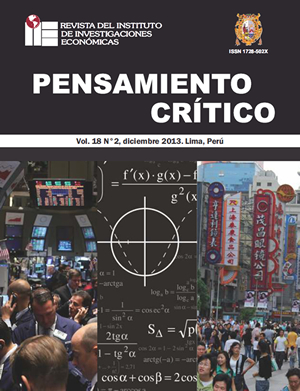Efectos de la política monetaria de flexibilización cuantitativa en Estados Unidos de América sobre el empleo
DOI:
https://doi.org/10.15381/pc.v18i2.8736Keywords:
Federal open market committing, monetary policy, tapering, accommodative policy, quantitative easing, federal reserve system, the balance of fed, open market operations, timing, nonfarm payroll, normally test.Abstract
The Federal Reserve System has the purpose to get the recovery economic and putting to the EE.UU.in the path to sustainable economic growth, for this the Fed come developing the quantitative easing programs, the same have for objective reduce unemployment rate to 6.5% for 2014; this could get, if the Fed designs a purchase program of assets; this mean inject of first power money to the economy, raising the balance of the Fed. In this way the Fed drops anchor the monetary policy to the evolution of the employ, this is expressed in the unemployment rate. The results hasn't been disappointing, but the employment objectives did not reach to the goals of the 2013 around of 6.5%, the last result was 7.%. Still the Fed in its december 2013 meeting began the tapering of monetary stimulus programs. This article, we study the relationship between Qe and the employ; specially with the Non Farm Payroll. The results we have obtained show us some grade of important relationship but it isn't overwhelming. We consider that the management of monetary policy has not been very consistent all the time with the conjuncture needs that market events would be unwrapped.Downloads
Published
Issue
Section
License
Copyright (c) 2013 Carlos Palomino Selem

This work is licensed under a Creative Commons Attribution-NonCommercial-ShareAlike 4.0 International License.
THE AUTHORS RETAIN THEIR RIGHTS:
a. The authors retain their trademark and patent rights, and also on any process or procedure described in the article.
b. The authors retain the right to share, copy, distribute, execute and publicly communicate the article published in Pensamiento Crítico (for example, place it in an institutional repository or publish it in a book), with recognition of its initial publication in Pensamiento Crítico.
c. The authors retain the right to make a subsequent publication of their work, to use the article or any part of it (for example: a compilation of their works, notes for conferences, thesis, or for a book), provided they indicate the source of publication (authors of the work, journal, volume, number and date).















